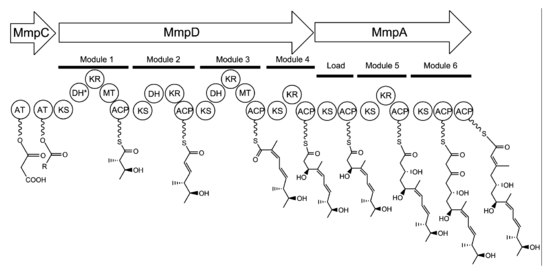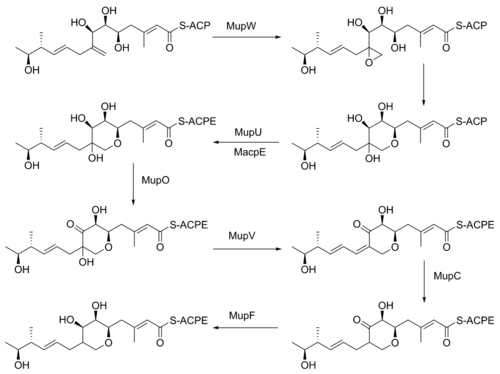Mupirocin
 | |
 | |
| Clinical data | |
|---|---|
| Trade names | Bactroban |
| AHFS/Drugs.com | Monograph |
| MedlinePlus | a688004 |
| License data | |
| Pregnancy category |
|
| Routes of administration | Topical, nasal |
| ATC code | D06AX09 (WHO) R01AX06 (WHO) |
| Legal status | |
| Legal status |
|
| Pharmacokinetic data | |
| Protein binding | 97% |
| Biological half-life | 20 to 40 minutes |
| Identifiers | |
| |
| CAS Number |
12650-69-0 |
| PubChem (CID) | 446596 |
| DrugBank |
DB00410 |
| ChemSpider |
393914 |
| UNII |
D0GX863OA5 |
| KEGG |
D01076 |
| ChEBI |
CHEBI:7025 |
| ChEMBL |
CHEMBL719 |
| ECHA InfoCard | 100.106.215 |
| Chemical and physical data | |
| Formula | C26H44O9 |
| Molar mass | 500.622 g/mol |
| 3D model (Jmol) | Interactive image |
| |
| |
| | |
Mupirocin (trade names Bactroban, Centany) is an antibiotic. It is used topically and is effective against Gram-positive bacteria, including MRSA.[1] Mupirocin is inactive for most anaerobic bacteria, mycobacteria, mycoplasma, chlamydia, yeast and fungi.[2]
Mupirocin is bacteriostatic at low concentrations and bactericidal at high concentrations.[3] It is of the monoxycarbolic acid class.[4] Mupirocin is a mixture of several pseudomonic acids, with pseudomonic acid A (PA-A) constituting greater than 90% of the mixture. Also present in mupirocin are pseudomonic acid B with an additional hydroxyl group at C8,[5] pseudomonic acid C with a double bond between C10 and C11, instead of the epoxide of PA-A,[6] and pseudomonic acid D with a double bond at C4` and C5` in the 9-hydroxy-nonanoic acid portion of mupirocin.[7]
It is on the World Health Organization's List of Essential Medicines, the most important medications needed in a basic health system.[8] It was originally isolated from Pseudomonas fluorescens,[9] developed by Beecham.
Medical uses
Mupirocin is used as a topical treatment for bacterial skin infections, for example, furuncle, impetigo, open wounds, etc. It is also useful in the treatment of methicillin-resistant Staphylococcus aureus (MRSA), which is a significant cause of death in hospitalized patients having received systemic antibiotic therapy. It is suggested, however, that mupirocin cannot be used for extended periods of time, or indiscriminately, as resistance does develop, and could, if it becomes widespread, destroy mupirocin's value as a treatment for MRSA. It may also result in overgrowth of non-susceptible organisms.
Resistance
Shortly after the clinical use of mupirocin began, strains of Staphylococcus aureus that were resistant to mupirocin emerged, with nares clearance rates of less than 30% success.[10][11] Two distinct populations of mupirocin-resistant S. aureus were isolated. One strain possessed low-level resistance, MuL, (MIC = 8–256 mg/L) and another possessed high-level resistance, MuH, (MIC > 256 mg/L).[10] Resistance in the MuL strains is probably due to mutations in the organism's wild-type isoleucinyl-tRNA synthetase. In E. coli IleRS, a single amino acid mutation was shown to alter mupirocin resistance.[12] MuH is linked to the acquisition of a separate Ile synthetase gene, mupA.[13] Mupirocin is not a viable antibiotic against MuH strains. Other antibiotic agents such as azelaic acid, nitrofurazone, silver sulfadiazine, and ramoplanin have been shown to be effective against MuH strains.[10]
Most strains of Propionibacterium acnes, a causative agent of the skin disease acne vulgaris, are naturally resistant to mupirocin.[14]
The mechanism of mupirocin differs from other clinical antibiotics, rendering cross-resistance to other antibiotics unlikely.[10] However, the MupA gene may co-transfer with other antibacterial resistance genes. This has been observed already with resistance genes for triclosan, tetracycline, and trimethoprim.[10]
Mechanism
Mupirocin reversibly binds to the isoleucyl t-RNA synthetase in Staphylococcus aureus and Streptococcus, resulting in inhibition of protein synthesis. DNA and cell wall formation are also negatively impacted to a lesser degree.[15] The inhibition of RNA synthesis was shown to be a protective mechanism in response to a lack of one amino acid, isoleucine.[16] In vivo studies in Escherichia coli demonstrated that pseudomonic acid inhibits isoleucine t-RNA synthetase (IleRS).[1] This mechanism of action is shared with furanomycin, an analog of isoleucine.[17]
Biosynthesis





Biosynthesis of pseudomonic acid A
The 74 kb mupirocin gene cluster contains six multi-domain enzymes and twenty-six other peptides (Table 1).[18] Four large multi-domain type I polyketide synthase (PKS) proteins are encoded, as well as several single function enzymes with sequence similarity to type II PKSs.[18] Therefore, it is believed that mupirocin is constructed by a mixed type I and type II PKS system. The mupirocin cluster exhibits an atypical acyltransferase (AT) organization, in that there are only two AT domains, and both are found on the same protein, MmpC. These AT domains are the only domains present on MmpC, while the other three type I PKS proteins contain no AT domains.[18] The mupirocin pathway also contains several tandem acyl carrier protein doublets or triplets. This may be an adaptation to increase the throughput rate or to bind multiple substrates simultaneously.[18]
Pseudomonic acid A is the product of an esterification between the 17C polyketide monic acid and the 9C fatty acid 9-hydroxy-nonanoic acid. The possibility that the entire molecule is assembled as a single polyketide with a Baeyer-Villiger oxidation inserting an oxygen into the carbon backbone has been ruled out because C1 of monic acid and C9' of 9-hydroxy-nonanoic acid are both derived from C1 of acetate.[20]
| Gene | Function |
|---|---|
| mupA | FMNH2 dependent oxygenase |
| mmpA | KS ACP KS KR ACP KS ACP ACP |
| mupB | 3-oxoacyl-ACP synthase |
| mmpB | KS DH KR ACP ACP ACP TE |
| mmpC | AT AT |
| mmpD | KS DH KR MeT ACP KS DH KR ACP KS DH KR MeT ACP KS KR ACP |
| mupC | NADH/NADPH oxidoreductase |
| macpA | ACP |
| mupD | 3-oxoacyl-ACP reductase |
| mupE | enoyl reductase |
| macpB | ACP |
| mupF | KR |
| macpC | ACP |
| mupG | 3-oxoacyl-ACP synthase I |
| mupH | HMG-CoA synthase |
| mupJ | enoyl-CoA hydratase |
| mupK | enoyl-CoA hydratase |
| mmpE | KS hydrolase |
| mupL | putative hydrolase |
| mupM | isoleucyl-tRNA synthase |
| mupN | phosphopantetheinyl transferase |
| mupO | cytochrome P450 |
| mupP | unknown |
| mupQ | acyl-CoA synthase |
| mupS | 3-oxoacyl-ACP reductase |
| macpD | ACP |
| mmpF | KS |
| macpE | ACP |
| mupT | ferredoxin dioxygenase |
| mupU | acyl-CoA synthase |
| mupV | oxidoreductase |
| mupW | dioxygenase |
| mupR | N-AHL-responsive transcriptional activator |
| mupX | amidase/hydrolase |
| mupI | N-AHL synthase |
Monic acid biosynthesis
Biosynthesis of the 17C monic acid unit begins on MmpD (Figure 1).[18] One of the AT domains from MmpC may transfer an activated acetyl group from acetyl-Coenzyme A (CoA) to the first ACP domain. The chain is extended by malonyl-CoA, followed by a SAM-dependent methylation at C12 (see Figure 2 for PA-A numbering) and reduction of the B-keto group to an alcohol. The dehydration (DH) domain in module 1 is predicted to be non-functional due to a mutation in the conserved active site region. Module 2 adds another two carbons by malonyl-CoA extender unit, followed by ketoreduction (KR) and dehydration. Module three adds a malonyl-CoA extender unit, followed by SAM-dependent methylation at C8, ketoreduction, and dehydration. Module 4 extends the molecule with a malonyl-CoA unit followed by ketoreduction.
Assembly of monic acid is continued by the transfer of the 12C product of MmpD to MmpA.[18] Two more rounds of extension with malonyl-CoA units are achieved by module 5 and 6. Module 5 also contains a KR domain.
Post-PKS tailoring
The keto group at C3 is replaced with a methyl group in a multi-step reaction (Figure 3). MupG begins by decarboxylating a malonyl-ACP. The alpha carbon of the resulting acetyl-ACP is linked to C3 of the polyketide chain by MupH. This intermediate is dehydrated and decarboxylated by MupJ and MupK, respectively.[18]
The formation of the pyran ring requires many enzyme-mediated steps (Figure 4). The double bond between C8 and C9 is proposed to migrate to between C8 and C16.[19] Gene knockout experiments of mupO, mupU, mupV, and macpE have eliminated PA-A production.[19] PA-B production is not removed by these knockouts, demonstrating that PA-B is not created by hydroxylating PA-A. A knockout of mupW eliminated the pyran ring, identifying MupW as being involved in ring formation.[19] It is not known whether this occurs before or after the esterification of monic acid to 9-hydroxy-nonanoic acid.
The epoxide of PA-A at C10-11 is believed to be inserted after pyran formation by a cytochrome P450 such as MupO.[18] A gene knockout of mupO abolished PA-A production but PA-B, which also conatins the C10-C11 epoxide, remained.[19] This indicates that MupO is either not involved or is not essential for this epoxidation step.
9-Hydroxy-nonanoic acid biosynthesis
The nine-carbon fatty acid 9-hydroxy-nonanoic acid (9-HN) is derived as a separate compound and later esterified to monic acid to form pseudomonic acid. 13C labeled acetate feeding has shown that C1-C6 are constructed with acetate in the canonical fashion of fatty acid synthesis. C7' shows only C1 labeling of acetate, while C8' and C9' show a reversed pattern of 13C labeled acetate.[20] It is speculated that C7-C9 arises from a 3-hydroxypropionate starter unit, which is extended three times with malonyl-CoA and fully reduced to yield 9-HN. It has also been suggested that 9-HN is initiated by 3-hydroxy-3-methylglutaric acid (HMG). This latter theory was not supported by feeding of [3-14C] or [3,6-13C2]-HMG.[21]
It is proposed that MmpB to catalyzes the synthesis of 9-HN (Figure 5). MmpB contains a KS, KR, DH, 3 ACPs, and a thioesterase (TE) domain.[18] It does not contain an enoyl reductase (ER) domain, which would be required for the complete reduction to the nine-carbon fatty acid. MupE is a single-domain protein that shows sequence similarity to known ER domains and may complete the reaction.[18] It also remains possible that 9-hydroxy-nonanoic acid is derived partially or entirely from outside of the mupirocin cluster.
Mupirocin versus fusidic acid
Both 2 percent ointments are applied to patients 3 times daily for 7 days to cure primary and secondary skin infections. The mupirocin bacteriologic cure rate is 97 percent and the fusidic acid bacteriologic cure rate is 87 percent,[22] but mupirocin is more expensive than fusidic acid.
References
- 1 2 Hughes J, Mellows G (October 1978). "Inhibition of isoleucyl-transfer ribonucleic acid synthetase in Echerichia coli by pseudomonic acid". Biochem. J. 176 (1): 305–18. PMC 1186229
 . PMID 365175.
. PMID 365175. - ↑ "Product Monograph Bactroban" (PDF). Retrieved September 8, 2014.
- ↑ Moodabe, Kate; Linda Bryant. "Topical antibiotics - more harm than good?". Focus. p. 1. Retrieved 2007-04-20.
- ↑ Mupirocin Archived August 12, 2014, at the Wayback Machine. by antimicrobe.org Editorial Board Archived August 23, 2012, at the Wayback Machine.. Retrieved June 2012
- ↑ Chain EB, Mellows G (1977). "Pseudomonic acid. Part 3. Structure of pseudomonic acid B". J. Chem. Soc. Perkin Trans. I (3): 318–24. doi:10.1039/p19770000318. PMID 402373.
- ↑ Clayton, J; O'Hanlon, Peter J.; Rogers, Norman H. (1980). "ScienceDirect - Tetrahedron Letters: The structure and configuration of pseudomonic acid C". Tetrahedron Letters. 21 (9): 881. doi:10.1016/S0040-4039(00)71533-4.
- ↑ O'Hanlon, PJ; Rogers, NH; Tyler, JW (1983). "The chemistry of pseudomonic acid. Part 6. Structure and preparation of pseudomonic acid D". Journal of the Chemical Society, Perkin Transactions 1: 2655–2657. doi:10.1039/P19830002655.
- ↑ "WHO Model List of EssentialMedicines" (PDF). World Health Organization. October 2013. Retrieved 22 April 2014.
- ↑ Fuller AT, Mellows G, Woolford M, Banks GT, Barrow KD, Chain EB (December 1971). "Pseudomonic acid: an antibiotic produced by Pseudomonas fluorescens". Nature. 234 (5329): 416–7. doi:10.1038/234416a0. PMID 5003547.
- 1 2 3 4 5 Cookson BD (January 1998). "The emergence of mupirocin resistance: a challenge to infection control and antibiotic prescribing practice". J. Antimicrob. Chemother. 41 (1): 11–8. doi:10.1093/jac/41.1.11. PMID 9511032.
- ↑ Worcester, Sharon (March 2008). "Topical MRSA Decolonization Is Warranted During Outbreaks". American College of Emergency Physicians. Elsevier Global Medical News. Retrieved 18 November 2013.
- ↑ Yanagisawa T, Lee JT, Wu HC, Kawakami M (September 1994). "Relationship of protein structure of isoleucyl-tRNA synthetase with pseudomonic acid resistance of Escherichia coli. A proposed mode of action of pseudomonic acid as an inhibitor of isoleucyl-tRNA synthetase". J. Biol. Chem. 269 (39): 24304–9. PMID 7929087.
- ↑ Gilbart J, Perry CR, Slocombe B (January 1993). "High-level mupirocin resistance in Staphylococcus aureus: evidence for two distinct isoleucyl-tRNA synthetases". Antimicrob. Agents Chemother. 37 (1): 32–8. doi:10.1128/aac.37.1.32. PMC 187600
 . PMID 8431015.
. PMID 8431015. - ↑ "Antibiotic Susceptibility of Propionibacterium acnes.". ScienceOfAcne.com. 2011-06-11. Retrieved 2012-08-27.
- ↑ Hughes J, Mellows G (April 1978). "On the mode of action of pseudomonic acid: inhibition of protein synthesis in Staphylococcus aureus". J. Antibiot. 31 (4): 330–5. doi:10.7164/antibiotics.31.330. PMID 659331.
- ↑ Haseltine WA, Block R (May 1973). "Synthesis of Guanosine Tetra- and Pentaphosphate Requires the Presence of a Codon-Specific, Uncharged Transfer Ribonucleic Acid in the Acceptor Site of Ribosomes". Proc. Natl. Acad. Sci. U.S.A. 70 (5): 1564–8. doi:10.1073/pnas.70.5.1564. PMC 433543
 . PMID 4576025.
. PMID 4576025. - ↑ Tanaka K, Tamaki M, Watanabe S (November 1969). "Effect of furanomycin on the synthesis of isoleucyl-tRNA". Biochim. Biophys. Acta. 195 (1): 244–5. doi:10.1016/0005-2787(69)90621-2. PMID 4982424.
- 1 2 3 4 5 6 7 8 9 10 11 El-Sayed AK, Hothersall J, Cooper SM, Stephens E, Simpson TJ, Thomas CM (May 2003). "Characterization of the mupirocin biosynthesis gene cluster from Pseudomonas fluorescens NCIMB 10586". Chem. Biol. 10 (5): 419–30. doi:10.1016/S1074-5521(03)00091-7. PMID 12770824.
- 1 2 3 4 5 Cooper SM, Laosripaiboon W, Rahman AS, et al. (July 2005). "Shift to Pseudomonic acid B production in P. fluorescens NCIMB10586 by mutation of mupirocin tailoring genes mupO, mupU, mupV, and macpE". Chem. Biol. 12 (7): 825–33. doi:10.1016/j.chembiol.2005.05.015. PMID 16039529.
- 1 2 Feline TC, Jones RB, Mellows G, Phillips L (1977). "Pseudomonic acid. Part 2. Biosynthesis of pseudomonic acid A". J. Chem. Soc. Perkin Trans. I (3): 309–18. doi:10.1039/p19770000309. PMID 402372.
- ↑ Martin, FM; Simpson, TJ (1989). "Biosynthetic studies on pseudomonic acid (mupirocin), a novel antibiotic metabolite of Pseudomonas fluorescens". Journal of the Chemical Society, Perkin Transactions 1: 207–209. doi:10.1039/P19890000207.
- ↑ Gilbert M. "Topical 2% mupirocin versus 2% fusidic acid ointment in the treatment of primary and secondary skin infections". Retrieved August 21, 2014.
External links
- Bactroban Prescribing Information GlaxoSmithKline
- Bactroban Nasal Prescribing Information GlaxoSmithKline